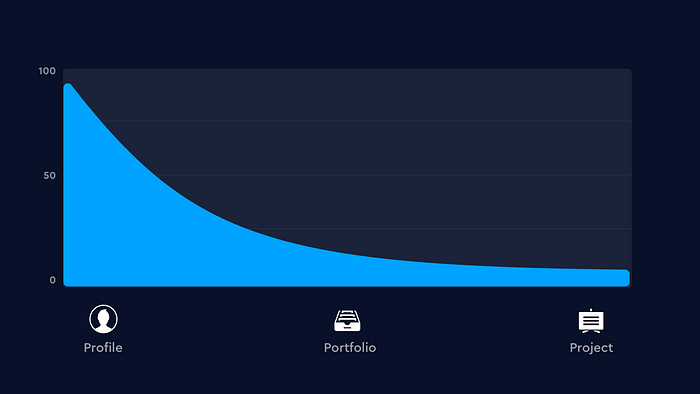Design Portfolios from the Eyes of a Manager

Much has been written about how to make design portfolios. I want to depart from theoretical notions and discuss how design portfolios are perceived by recruiters and design managers.
The first question which is worth asking yourself is: “is portfolio needed at all?”. To this question there is only an ambiguous answer — sometimes. I have hired people who didn’t have portfolios and there are many similar examples. In order to judge the designer’s skills, some form of test usually suffices. At other times a personal recommendation or acquaintance can help to find a job, although even this is sometimes not enough. Sooner or later, the need for a portfolio will become evident.
Many people talk about the importance of detailed cases in portfolio, analyze their proper number and relevance. However, these factors are often of no importance to employers. Instead, a portfolio is vital because it allows recruiters to quickly find your work and create a detailed and visible representation of you as a designer. This is the true purpose of a portfolio and it has the added bonus of giving you the opportunity to present your experience.
Increase View Conversion
The number of views to your profile, then subsequently to your portfolio and projects, converts as in the graph below.

Your job is to increase the conversion of views from your profile to your portfolio.
The vast majority of HR managers open CV, but don’t find links to your site, Behance, Dribbble or other social media. To be honest, I myself sometimes miss the treasured links in the body of CV. There are two simple solutions to this problem:
- Place links to your work both at the beginning and the end of your resume
- Place links to projects in the body of the CV
These steps will make skipping links to your portfolio much more difficult when you have provided them in your CV with descriptions of the projects. It will also make the relevance of your experience in the given context immediately obvious to hiring managers.
The Recruiter is a User
The designer should first and foremost consider the user, and in this case the user is synonymous with the recruiter or design manager. You must ask yourself how your user works. Your average user views dozens of resumes and portfolios a week. Their eyes tire from the constant viewing hundreds of images and they know all the angles of the isometry from which you can show your works. But, the most important thing to understand about recruiters is that they will not spend much time on one person. The manager’s task is to select the initial candidates, which means they will not waste time downloading obscure files or rummaging through your cloud storage like some kind of digital binman.
Gather together all your work into one resource, so that it is easily accessible and enables speedy viewing. If one part of your work is presented on Behance, another part on a personal site and still another on Dribbble, then the conversion of views to your fragmented portfolio will be dramatically reduced.
By saving the recruiter time you will increase the conversion rate for your portfolio.
There are also a number of additional side effects that will result from of a lack of structure in the way your work is presented. Not only will your conversion be reduced, but it may suggest disorganisation on your part. If I come across such portfolios as a design manager, it makes me question whether the designer has considered the user at all or if they have any empathy for the user's experience. This would be a major professional flaw and a red flag for me as a manager.
A Portfolio Presents the Designer
You should view your portfolio as more than merely a demonstration of your work, but as a means to present yourself as a specialist. This should be obvious to any designer but embracing this idea will help you look at your work from a new angle.
Your portfolio should be comprised of your experience, not based on the amount of work you have done. After all, the recruiter is not buying your past projects, but hiring you as a professional. The work in your portfolio represents you and reflects part of your experience as a designer. When compiling your portfolio, you should be guided by a simple principle: you are the product and the portfolio is the landing page. This notion works in a variety of situations, whether you have been working under an NDA or even if you have spent the last few years preparing a design system or integrating design with code.
It is important to remember that your experience and skills may not always be evident or inferred from the projects you have completed, presented in pictorial form. Your capabilities can be presented in the form of a short story about yourself, links to articles or speeches.
Recruiters are Investors
Imagine you are doing a presentation for an investor. In just two minutes you need to present the essence of your project and capture their interest. Your presentation has to be as informative and succinct as possible. You must tell them who you are; where you have worked and with what kind of clients and colleagues; what projects you have worked on and most importantly what you are capable of. After reviewing your presentation, the recruiter makes a decision as to whether or not you are worthy to invest of their time and the time of the team. This means that your portfolio must reflect the breadth and depth of your experience. The number of works included varies and there is no universal rule or standard, but you need to show just enough to illustrate your experience and skills.
Design Resources Depersonalise like School Uniforms
Every time I look at works on Behance, I have realised that I do not treat the works as if they are the product of a particular candidate or person, but rather as if they are a stream of homogenous pictures.
This occurs for several reasons. Firstly, design resources are developed exclusively to present works and do not pay attention to the designers. Recruiters using these sites lose the logical connection in their heads between designers and their completed projects and so the purpose of presenting yourself through portfolios is lost when you use them.

Unified canons of presentation remove any individuality from your work and deprive your portfolio of its personality, making them forgettable. Excessive design in presentation gives additional gloss to the works but does not make them better. Beautiful backgrounds, isometry, and other design techniques only have the effect of causing the designer’s individuality to be lost.
These popular methods of presenting projects have a similar effect to that of a school uniform. Two dozen children clad with white tops and dark bottoms appear to the casual observer as a homogenous crowd. This is the second reason why using design resources is not always justified. An important goal of the portfolio is lost — to catch the eye in a set.
Showing Old Projects
I have read many times that there is no point in including old works or projects in a portfolio. I am dubious of such statements. There are a multitude of reasons for presenting some of your less recent works in your portfolio:
- The work may be interesting to your employer with regard to the breadth of your experience.
- The work may demonstrate the progress you have made. It is very important for me to understand as a manager whether or not you have improved as a designer and in what way.
- Old works may demonstrate your mastery of design. If you did a great job five years ago that still looks fresh, then this shows your proficiency. The ability to do work outside of time is a sign of the designer’s maturity.
Give Credit Where Credit Is Due
This is a fundamental and often overlooked part of a portfolio. You must identify the help and innovation that your colleagues made which contributed to the project’s success. This is the ethical thing to do, it shows you are a team player and that you have integrity and a moral compass.
Conclusion
I would like to summarise the approach in one sentence briefly — the product approach should be in any aspect of your work.
Try a simple UX test of your portfolio. This can be done by showing your presentation to three or four people who play different roles in the IT industry. Give them just two minutes to look at it then ask them simple questions: “What is this site about?”, “What can you say about this designer?” Ascertain what people remembered and understood from their short viewing. This test will highlight the major problem areas and lead to a refinement of the design project.

